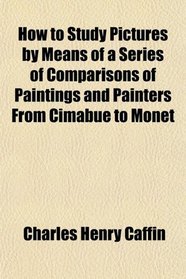Search -
How to Study Pictures by Means of a Series of Comparisons of Paintings and Painters From Cimabue to Monet
How to Study Pictures by Means of a Series of Comparisons of Paintings and Painters From Cimabue to Monet
Author:
Subtitle: With Historical and Biographical Summaries and Appreciations of the Painters' Motives and Methods General Books publication date: 2009 Original publication date: 1905 Original Publisher: The Century Co. Subjects: Painting Art appreciation Art / General Art / Criticism Art / History / General Art / European Art / I... more »
Author:
Subtitle: With Historical and Biographical Summaries and Appreciations of the Painters' Motives and Methods General Books publication date: 2009 Original publication date: 1905 Original Publisher: The Century Co. Subjects: Painting Art appreciation Art / General Art / Criticism Art / History / General Art / European Art / I... more »
ISBN-13: 9781150559723
ISBN-10: 1150559721
Publication Date: 12/21/2009
Pages: 238
Rating: ?
ISBN-10: 1150559721
Publication Date: 12/21/2009
Pages: 238
Rating: ?
0 stars, based on 0 rating
Genres:




